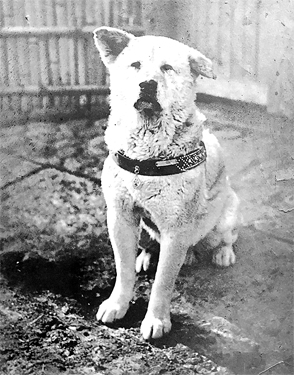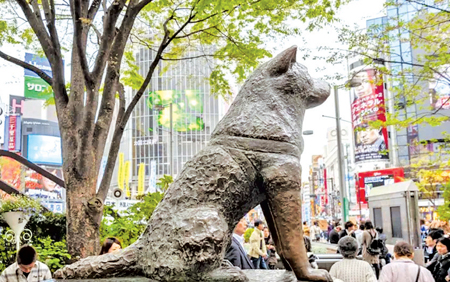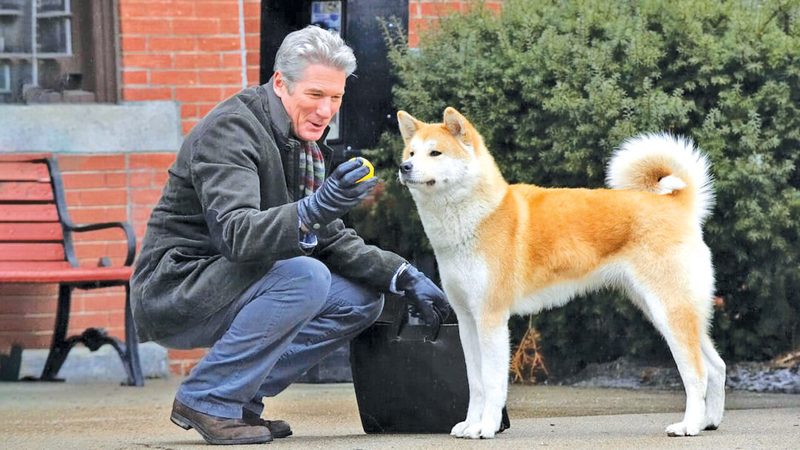Every day, in the heart of Tokyo’s buzzing Shibuya district, thousands of people pass by a small bronze statue near one of the busiest train stations in the world. Some stop to take photographs. Others pause for a moment of quiet. A few know the story. Fewer still feel it.
That statue is of a dog — ears slightly perked, eyes fixed forward, tail curled. His name was Hachikō. Nearly a century ago, he stood in that same spot, not as bronze, but as flesh and fur. He was waiting. For a man who would never come back.
And he kept waiting. Day after day. Year after year.
This is the story of Japan’s most loyal dog — and why, almost 100 years later, people still remember him.
A simple life begins

Hachiko
Hachikō was born in 1923 in Japan’s Akita Prefecture, a northern region known for heavy snow, deep forests, and sturdy working dogs. He was an Akita — a proud, powerful breed with a thick coat and quiet dignity.
As a puppy, Hachikō was sent to Tokyo, to live with Prof. Hidesaburō Ueno, a kind, reserved man who taught agricultural engineering at Tokyo Imperial University. Ueno lived in the Shibuya area, and he and the pup quickly settled into a routine.
Each morning, Hachikō would walk with the professor to Shibuya Station. He would wait patiently as Ueno boarded the train to work. Then, in the afternoon, he would return to the station at the exact time the train was due, standing among the crowds and searching for his owner’s face.
Every day. Rain or shine
It became a quiet ritual. Station workers and commuters began to recognise the pair. There goes the professor, they’d say. And there’s the dog who walks him home.
On May 21, 1925, something went wrong. Prof. Ueno collapsed during a lecture and died suddenly of a cerebral haemorrhage. He never made it back to Shibuya Station.
But Hachikō didn’t know that. That afternoon, he waited at the usual spot. The train came. The crowds passed. But the professor didn’t arrive.
Still, Hachikō returned the next day. And the next. And the day after that.
He waited at the same time, at the same place. For one year. Two years. Five. Seven. Nine.
He became part of the station. He would sit near the ticket gates, quietly watching. Some commuters ignored him. Some offered him food. A few tried to chase him off. But he never stopped coming.
No matter the weather. No matter how many years passed. Hachikō was there.
A nation takes notice
In 1932, a former student of Professor Ueno, now a researcher of Japanese dog breeds, wrote an article about Hachikō’s loyalty. It was published in one of Tokyo’s largest newspapers.
Suddenly, Hachikō wasn’t just a station dog. He was a national icon.
People began visiting Shibuya Station just to see him. Schoolchildren brought him snacks. Artists sketched him.
Writers praised him. He became a living symbol of devotion, loyalty, and love that asked for nothing in return.
In a country where values like perseverance, humility, and honour hold deep meaning, Hachikō’s story struck a chord. His loyalty was pure. Silent. Unshaken. In 1934, while he was still alive, a bronze statue of Hachikō was unveiled outside Shibuya Station. Hachikō himself was present at the ceremony.
He didn’t understand the fanfare. He just waited.
The final wait

A statue of Hachiko has stood outside Shibuya station in Tokyo since 1948
On March 8, 1935, after nearly ten years of daily visits to the station, Hachikō died on a street near Shibuya. He was around 11 years old.
His body was found in a quiet alley, curled up as if he were resting.
He was cremated, and his ashes were placed next to Prof. Ueno’s grave at Aoyama Cemetery — at last, side by side.
But that wasn’t the end.
His story didn’t fade. If anything, it grew louder. The statue at Shibuya remained a popular meeting point. When it was melted down during World War II for scrap metal, the people mourned. After the war, it was rebuilt. The new statue — the one still standing today — was made by the son of the original sculptor.
Hachikō had become more than a dog. He had become part of Japan’s cultural memory.
A place in the heart
Today, Hachikō’s statue is one of the most photographed spots in Tokyo. Tourists flock to it. Locals use it as a landmark — “I’ll meet you at Hachikō.” At 5 p.m. every day, a small bell chimes from the station speakers in his honor.
There’s even a small museum exhibit dedicated to him, and his story is taught in Japanese schools. His fur, preserved after his death, is displayed at the National Science Museum in Ueno.
In 2009, Hollywood made a film about his life — Hachi: A Dog’s Tale, starring Richard Gere. But in Japan, no one needed a movie to know who he was.
Ask an elderly commuter at Shibuya today, and they’ll tell you: Hachikō didn’t belong to one man. He belonged to all of us.
Why he still matters
What makes Hachikō’s story so powerful is its simplicity. He didn’t perform tricks. He wasn’t trained to do what he did. He didn’t act out of duty or fear. He waited because he loved someone — and he didn’t know how to stop.
In this world full of broken promises and short attention spans, Hachikō reminds us of a different kind of love. One that doesn’t need words.
One that shows up, every day, no matter what. It’s a kind of loyalty we rarely see — not just in dogs, but in people.
Maybe that’s why he still draws crowds, nearly 100 years later. Not because he was a legend. But because he was ordinary — and yet, he did something extraordinary. He waited. For someone he loved. Until the very end.







